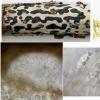
24-12-2025 17:08
Hulda Caroline HolteHello, I have found this propoloid ascomycete on

21-12-2025 09:32
Hello.A tiny ascomycete found embedded in wood in

21-12-2025 21:32
Pol DebaenstHello, Garden, Burgweg 19, Veurne, BelgiumOn 10/1

22-12-2025 23:38
Patrice TANCHAUDBonsoir, récolte sur un mur en pierre, apothéci

22-12-2025 00:47
Patrice TANCHAUDBonsoir, récolte à proximité du milieu dunaire
Coelomycete on Acer wood
Hans-Otto Baral,
21-06-2006 13:00
 Has anybody ever seen this coelomycete? It grew in Sweden (Skane, NP Söderasen, leg. Felix), on undecayed wood of a broken, 18 mm thick Acer branch obliquely hanging on the ground. Stromata 1.5-3 mm broad, 150-250 µm thick, pycnidial cavities 60-150 µm tall. Conidia *9.5-14 x 3.3-4 µm, conidiogenesis very probably phialidic.
Has anybody ever seen this coelomycete? It grew in Sweden (Skane, NP Söderasen, leg. Felix), on undecayed wood of a broken, 18 mm thick Acer branch obliquely hanging on the ground. Stromata 1.5-3 mm broad, 150-250 µm thick, pycnidial cavities 60-150 µm tall. Conidia *9.5-14 x 3.3-4 µm, conidiogenesis very probably phialidic. Zotto
Hans-Otto Baral,
05-08-2006 11:47

Re:Coelomycete on Acer wood
In the meantime, Walter Jaklitsch identified this fungus from my photos as the anamorph of a Diaporthe. In that genus the anamorphs are less diverse than the teleomorphs so that Walter prefers not to name this species from the anamorph alone. Actually, at least 5 Diaporthe species have been described on Acer. At the collection site there was Acer platanoides (natural) and A. pseudoplatanus (introduced), so one of these two Acer species must have been the host of this fungus.
According to Walter, a pseudostroma in the wood forming a so-called ventral zone (= black line in section) - as seen in our collection - is characteristic of many Diaporthe species, and is of course also found beneath the perithecia.
cheers
Zotto
According to Walter, a pseudostroma in the wood forming a so-called ventral zone (= black line in section) - as seen in our collection - is characteristic of many Diaporthe species, and is of course also found beneath the perithecia.
cheers
Zotto
